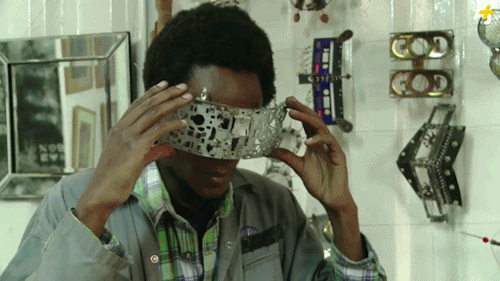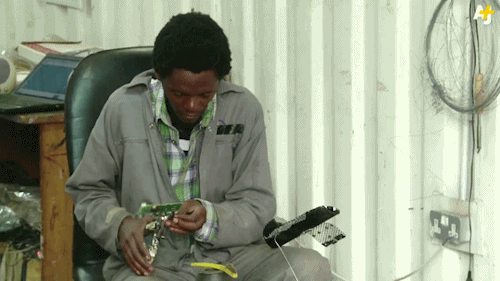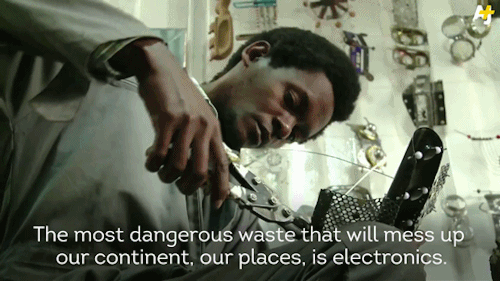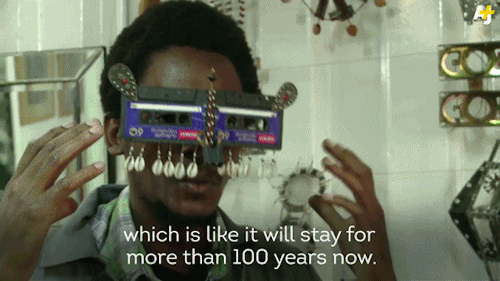Associationxamxam - African Digital Perspectives

More Posts from Associationxamxam and Others
Inner Cruise - Selly Raby Kane La mode oui, mais dans un monde magique. La styliste sénégalaise explore, expérimente refuse de se laisser enfermer. A suivre.
Wangechi Mutu and Her Post Human Kenyan Mutants by Edgar Arceneaux
Edgar Arceneaux: I did have a third category of how I see you using materials, which is synthetics, be it hair, mylar, sheets of vinyls that look like wood. These are things that have the qualities of being natural but are actually made with machines. Blurring the lines between organic and synthetic imbues your backgrounds with additional associations to concepts of science fiction. When we talked about particles, bleeds, and strains of interactions in your art materials, these are also the same fear-inducing qualities of the antagonist in much of science fiction, fantasy and horror genres films today. Dispersions of airborne viruses producing zombies or wiping out of society with an incurable disease, or on the genetic level, dealing with bio-technology, genetic manipulation, mutation, genetically altered foods and the cloning of human beings. All cause radical restructuring and conflict within both the human body, as well as the societal body. In most Hollywood films, disfigurement is treated as something to be suppressed, pushed back into the shadows, but in your work, you use it as a means to dispel illusions. In spite of that, your work is very seductive to so many people, could you talk about why you think that is?
Wangechi Mutu: I don't even know what people are actually seeing, I can only see through my eyes, or how it feels to be making it, or what if feels like to see these characters created in their environments. I do know that I have a deep fascination in what is considered to be "not-normal," what is considered to be the quintessential look where an ethnicity is considered to be normal. Who came up with and why? What is the purpose of coming up with those delineations and categories? In many ways I see it as a thread running through my work. I see it in pinups, in female insects to cyborgs, everything has this question of beauty, appearance, perception, our claim to understand a person's history and their intentions is based on appearance. That is why I play with this notion of what draws you in, what gives you a sense of comfort, gives you a set of codes that allows you to judge this person. "Oh, I know this person, they're morally in the right place," and I can therefore allow them in. As a non-American, as someone bureaucratically and officially alien, that term itself raises questions about what that means anyway. If you see any depictions of alien in Hollywood or mass media and apply it to yourself, there is inevitably going to be this disconnect or questioning. That's where some of those things come from.

via adacreate 11 May 2014 - 12 May 2014 / “Global Black Consciousness” Hôtel Sokhamon, Dakar, Senegal
The Institute for Comparative Modernities (Cornell University) and the Institute of African American Affairs (New York University) will hold the international conference “Global Black Consciousness” on May 11 and 12, 2014, in Dakar, Senegal. The conference is coordinated by Margo Natalie Crawford and Salah Hassan (Cornell University) and Manthia Diawara (NYU). The conference will coincide with the opening days of the Dakar Biennale (Dak’Art 2014), which opens on May 9, 2014. The two-day gathering will focus on the theme of “Global Black Consciousness,” with invited participants who will present new and unpublished work.
THEME/CONCEPT:
Now that we have such tremendous scholarship on particular identities shaped by the African diaspora (Afro-German, Black British, African American, Afro-Latina/o, Afro-Caribbean, and many more) and tremendous theories of the value and limits of Pan-Africanism, Afro-pessimism, and many other “isms,” how do we create a space for the critical and nuanced analysis of global black consciousness as both a citing of diasporic flows and a grounded site of decolonizing movement? This multi-event and multi-site conference aims to explore the confluence between theories of diaspora and theories of decolonization. Moreover, the crisscrossing of visual art, literature, film, and other cultural productions will be explored alongside the crosscurrent that shaped the transnational flow of black consciousness. The scholars participating in this conference will situate their work in the space of the crisscrossing that occurred as the Black freedom struggle became a layering of locations and dislocations and past, present, and future.
The 1960s and 70s will be the pivot point as we think about the precursors and legacies of the 1960s and 70s black freedom struggles. From May 9 to June 8, 2014, Dak’Art, la Biennale de l’Art Africain Contemporain, will be held in Dakar. The theme and the occasion allow to revisit major Black and Pan-African intellectual movements and festivals (such as the Dakar’s Festival of World Negro Arts of 1966, Algiers of 1969, and FESTAC 1977 in Lagos, Nigeria, among others) in addition to revisiting individual artistic and intellectual work tied to Africa and the African Diaspora.
The conference’s papers will be published in a co-edited volume entitled Global Black Consciousness.
Anticipation, le scénario africain
Ce matin sur France Culture l’économiste français, Nicolas Baverez, présentait son dernier ouvrage écrit sur le mode du roman d’anticipation, Lettres béninoises, dans lequel en 2040, un béninois, premier africain à diriger le FMI raconte à ses proches l’état de récession dans lequel il trouve la France. Comme en réponse, le journaliste Xavier De La Porte opposait un autre scénario anticipateur défendu par les Singularistes : celui d’une post-humanité dans laquelle l’humain aurait considérablement augmenté ses capacités en fusionnant avec les machines. Ce scénario est aujourd’hui réellement développé au sein de la Singularity University, elle-même portée par Google, la NASA et Ray Kurzweil, un scientifique/homme d’affaire/visionnaire.
A l’écoute de l’émission, je me suis demandé qu’elle était la place accordée au final à l’Afrique dans ces deux scénarii et à quoi pouvait-elle servir?
En fait, dans le premier, Lettres béninoises, l’Afrique fait partie d’un dispositif qui doit fonctionner comme un électrochoc pour que justement le scénario d’une faillite de la France n’advienne pas et dans le second, elle est totalement absente, du moins dans la façon dont Xavier De La Porte a monté sa chronique.
Cette absence contraste avec à la récente campagne L’Afrique connectée de Google qui se place comment étant au cœur du développement de l’Afrique. A travers une série de vidéos, Google montre comment des entrepreneurs africains « réussissent » professionnellement grâce justement aux outils du web et à Google.
Pourtant, à faire défiler les films très courts de la campagne, il en ressort une impression d’uniformisation qui s’oppose singulièrement à cette notion de Singularité défendue par la firme internationale et qui me fait penser que -quand même- Google défend une vision totalitaire d’un monde dans lequel nous devrions tous ressembler à l’idée qu’elle se fait du futur à savoir : un monde de technocrates blancs, masculins et singulièrement âgés.
Face à ces deux positions qui au final évacuent l'idée d'une participation active de l'Afrique, il me semble que la science-fiction africaine a un rôle à jouer. Celui d’écrire des histoires dans lesquelles il n’est fait table rase ni du passé, ni de la différence, ni de l’empathie, ni de la Nature et de la magie. Un monde multiple et donc chaotique mais singulièrement vivant.










Collages by: Jamilla Okubo
Shot and Directed by Sir Dex R. Jones
Garment Designs/Headpieces: Jamilla Okubo
Pattern Designs on Fabric: Jamilla Okubo
Model: Jamilla Okubo
This was a project for my final assignment, for my “Fashion, Illustration, & Performance” class at Parsons.. which could potentially become the start of my thesis for this year. The design process of these garments all started with two collages that I created with patterns that I made, then I decided to bring them to life by creating them into garments and wearing them myself.
-jamilla okubo




Making Wearables From E-Waste
Video short from AJ+ interviews Nairobi artist Cyrus Kabiru who creates wearable art from electronic waste:
Meet Cyrus Kabiru. The Nairobi, Kenya artist is turning e-waste into wearables and art.
Cyrus also has a Tumblr blog [cyruskabiruart] which you can find here









Gerald Machona: Vabvakure (People from Far Away) (Zimbabwe)
Artist Statement: “Central to this body of work is my use of various decommissioned currencies as an aesthetic material,” explains Machona, “in an attempt to link historic and contemporary trends of African diasporic migration on the continent. Most recently, the migration of Zimbabwean nationals into neighbouring SADC countries and abroad, following the country’s political and economic collapse. While South Africa hosts the largest population of these Zimbabwean nationals living in the diaspora, in May of 2008 they were amongst the foreign nationals persecuted by the xenophobic attacks. It was reported that people were targeted through a process of profiling that assumed authentic South Africans are lighter in complexion or fluent in an indigenous language; this resulted in 21 of the 62 casualties being local citizens. Such beliefs have complicated who is considered an ‘insider’ and ‘outsider’ in South African society. Pitting ‘native’ against ‘alien’ and perpetuating an exclusive sense of belonging that is reminiscent of apartheid doctrine. There is a growing need in the post-colony to deconstruct these notions of individual and collective identity, since ‘nations’, ‘nationalisms’ and ‘citizenry’ are no longer defined solely through indigeneity or autochthony.”

"Of whom and of what are we contemporaries? And, first and foremost, what does it mean to be contemporary?" Giorgio Agamben, Qu’est-ce que le contemporain?, Paris, Rivages, 2008. Photo: Icarus 13, Kiluanji Kia Henda
201 posts


